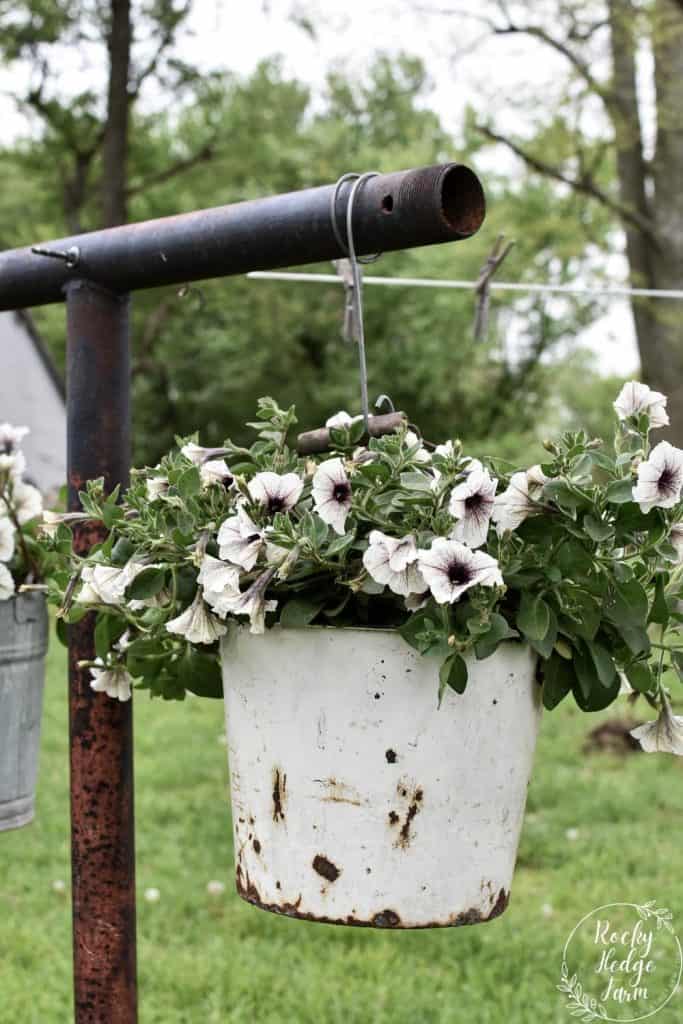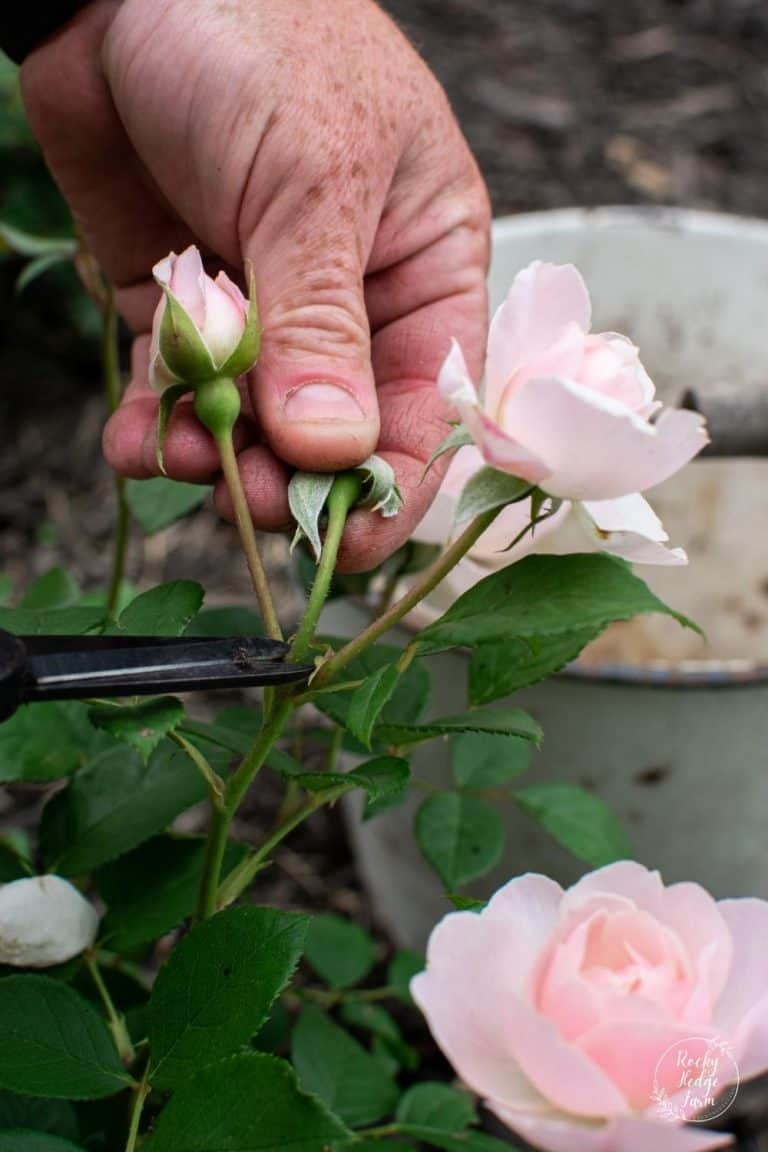Petunia Hanging Basket
Who doesn’t love flowers?! With just a few simple steps, you can learn how to make a petunia hanging basket that looks full and lush with trailing petunias for hanging baskets.
Flowers add color, joy, and beauty to any space. Whether you are looking to brighten up a front yard flower garden or a garden shed, or you are trying to add more color, adding hanging flower baskets can be the answer.

Types Of Petunias for Hanging Baskets
Trailing petunias for hanging baskets is easy to add color, texture, and life to a hanging basket. There are multiple petunias for hanging baskets with a wide array of colors to choose from.
They come in various colors and sizes as well, so you’re sure to find one that fits your preferences. Their easy upkeep makes them an excellent choice for making hanging baskets.
Grandiflora Petunia
The stunning, large blooms of the Petunia Grandiflora are also some of the largest blooms in all varieties. They are sturdy plants that can grow up to 12 inches tall and have up to 5-inch blooms. Besides their sensitivity to heat, humidity, and rain, they also need deadheading to keep them blooming continuously.
Grandifloras work well in hanging baskets with their trailing stems and showy blossoms. Despite the need for full sun, these plants can tolerate some light shade but will need protection from the wind.

Multiflora Petunia
Multiflora petunias are smaller plants with a more compact growth habit with numerous smaller blooms. The stems are strong, and the flower is about 2 inches in diameter.
Multiflora petunia varieties are suitable for windy climates and hold up well against the rain. Multiflora works well when planted in hanging baskets.
Wave Petunias
Wave petunias are a more recent addition, and they only grow 6 inches tall. The plants can spread 2 to 4 feet and have blooms about 2 inches across.
Wave petunias do not need deadheading and tolerate heat and drought. Wave petunias make great trailing plants for hanging baskets.

Supertunia Petunias
Supertunias are one of the most popular and my personal favorite! They are extremely vigorous growers and bloomers in various colors in single and double blooms.
They require frequent feedings, at least once a month, to stay at their peak bloom after bloom.
Supertunias are weather-tolerant, and during the heat of the summer, they tolerate the heat and humidity.
They bloom profusely and self-dead-head. They have medium to large-sized flowers that are about 2 inches across.
Supertunias petunias have shorter stems that have more leaves and flowers. They generally stand around 6-10 inches tall with a spread of 18-24 inches.
Supertunia petunias are the best petunias for hanging baskets, creating a beautiful spilling flower display over the edges.

My Favorite Petunia for Hanging Baskets
My favorite petunia is the Supertunia® Latte. This unique plant thrives all season long with incredible color from spring until the first frost in fall.
The vibrant ivory petals contrast beautifully with the dark purple-black streaks of the flower, making for a stunning display.
Each year, I am impressed with the beauty and fullness of the Latte variety in my supertunia hanging basket.

How many Trailing Petunias in a Hanging Basket?
The general thought for how many trailing petunias to put in a hanging basket is that for a 12-14 inch basket, you should use 3-5 plants. In a 16-18 inch basket, you can use 5-7 trailing petunias.
It’s often difficult to judge how many trailing petunias to use per hanging basket. If you want a full and lush look right away, you can pack more petunias into a hanging basket.
The more petunias you pack in the basket, the more root competition there will be. Hanging baskets have a shorter amount of time to reach their full potential, so water and fertilizer are essential to help this process.

Do Petunias Do Well In Hanging Baskets?
Planting petunias in hanging baskets is the perfect way to add color and visual interest to any porch, patio, or window box planter. Petunias are easy to grow and thrive in full sun with well-drained soil.
Look for cascading petunias as these hybrids produce flowers on long, flowing stems, making them perfect for hanging baskets and window boxes.

Do Petunias Like Sun or Shade?
Petunias need sunlight. It is recommended that petunias have 5 or 6 hours of good, unfiltered sunlight every day to grow optimally. If they are in a shadier location, they will produce fewer flowers.

What Month is Best to Plant Petunias in Baskets?
After the threat of frost has passed, mid-spring is the best time to plant a trailing petunia hanging basket. Petunias can be planted outside when nighttime temperatures are above 50F.

Do Petunias Grow Back Every year?
Most gardeners treat petunias as flowering annuals. They can be grown as perennials in the warmest USDA zones 10 and 11. Petunias die as soon as the temperature drops to 32 degrees Fahrenheit.

What is the Best Soil Mix for Petunias
When planting a hanging basket, choose a potting mix made for containers. They are usually lightweight and are composed of slow-release or continuous-release fertilizers to provide plants with all their necessary nutrients.
Potting mix will also include inorganic and organic matter like sphagnum peat moss, perlite, vermiculite, and earthworm castings, providing an excellent soil environment for your potted plants.
The potting mix helps improve the aeration, allows the water to drain correctly, and helps to give your plants the nutrition balance they need.

How Long Do Petunias Last?
Petunias are most often grown as annuals and only grow from spring until the first frost. If you live in warmer climates, Zone 10 and 11, petunias can last between 2 and 3 years.

Materials to Make a Petunia Hanging Basket
- Potting Mix: A great potting mix is crucial to the success of your hanging basket, especially if you want it to thrive and produce flowers. Buying a high-quality potting mix ensures that your plants will flourish and not suffer from a lack of nutrients.
- Hanging Baskets: Hanging baskets come in a variety of shapes and sizes. One thing you should keep in mind when buying one for outdoor use is that it needs to be resistant to the elements.
- Flower Starts: For this post, I am using Supertunia® Latte
- Fertilizer: slow-release fertilizers are ideal for petunia hanging baskets because they release nutrients slowly into the soil.
- Garden Trowel: this trowel is ideal for digging the holes to plant petunias in hanging baskets.

How to Make A Petunia Hanging Basket
Petunias have always been a popular annual flower. For continuous blooms all season long here is how to plant a trailing petunia hanging basket!
Step 1: Select the Hanging Site and Install Hooks
There are so many great places to hang flowering petunia baskets. The edges of a porch on the house or garden shed, deck edges, garden arbors, and even clothesline poles.
Make sure you use a strong beam or post for support. A lot of weight can accumulate in a planter, as watered-in planters can become quite heavy.
Step 2: Choose a Hanging Basket
When you’re planning to plant your petunias in a hanging basket, consider the size of your basket and how well it holds moisture. Large hanging baskets will hold moisture better, possibly needing less watering, while smaller baskets will require more watering.
Hanging baskets are exposed to extreme elements like wind, rain, and more. When choosing your hanging plant container, consider selecting weather-resistant materials, such as plastic or metal.
Another option is to use old galvanized containers, especially buckets with handles to plant in. I have an entire post dedicated to planting in galvanized containers as well as ideas and inspiration from my own gardens!
Step 3: Add Potting Mix
When planting a petunia hanging basket, choose a high-quality potting mix. A potting mix is a soilless garden medium explicitly made for growing plants in containers.
As you pour the soil into the hanging basket, make sure there’s an inch or so between the top of the soil and the rim of the basket.
Step 4: Add Your Plants
Using a trowel, dig a hole in the potting mix in the center of the basket. Gently remove the petunia from the pot and loosen the roots.
Place the plant into the hole and fill in the soil around it. Pat the soil to rid of any air pockets. Continue adding the rest of the petunias around the basket.

Step 5: Add Slow Release Fertilizer
As a gardener, you want to ensure your plants are getting the nutrients they need to grow. This is especially important when you’re dealing with hanging baskets where a lot of the nutrients are leached out of the soil.
The slow-release fertilizers are ideal for petunia hanging baskets because they release nutrients slowly into the soil. They supply nutrients into the soil and keep the plants healthy over the growing season.
Step 6: Water Well
After you have planted your petunias in the hanging basket, water them well. The best technique is to water your plants a little bit, give them a chance to absorb the water, and then add more water a few minutes later until the potting mix feels saturated.

Learning how to make a hanging basket with petunias is a great way to add an extra burst of color to any garden space. A trailing petunia basket is an excellent choice for those with limited square footage in their garden area and who want flowers that attract hummingbirds and butterflies.
More Flower Gardening Inspiration
You’re going to love these articles if you’re a gardener or just looking to get some garden inspiration. In these posts, I share some of my favorite plants for the flower garden, and also offer some inspiration and ideas for container planting and garden shed decor.






I, also enjoy all white flowers. As you stated, they just stand out against the green foliage. Also, your style of photography is amazing. It makes even the minute detail beautiful. Thanks for sharing.